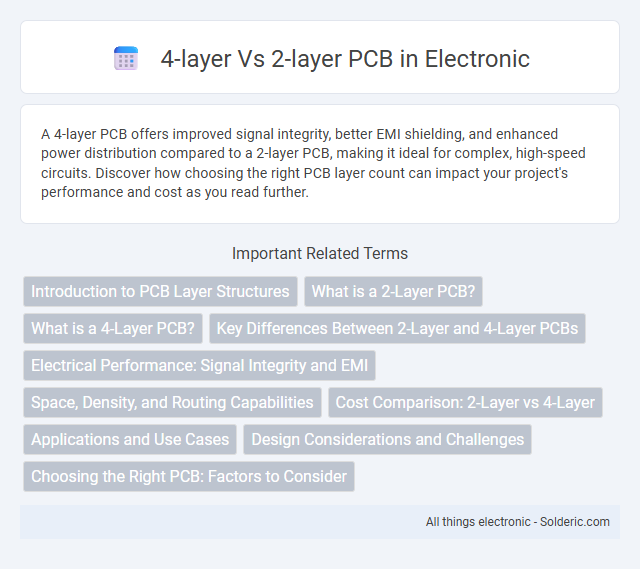A 4-layer PCB offers improved signal integrity, better EMI shielding, and enhanced power distribution compared to a 2-layer PCB, making it ideal for complex, high-speed circuits. Discover how choosing the right PCB layer count can impact your project's performance and cost as you read further.
Comparison Table
| Feature | 4-Layer PCB | 2-Layer PCB |
|---|---|---|
| Layers | Four copper layers | Two copper layers |
| Signal Integrity | Higher, less interference | Lower, prone to crosstalk |
| Size | Compact for complex circuits | Larger size for same complexity |
| Cost | Higher manufacturing cost | Lower manufacturing cost |
| Thermal Management | Improved heat dissipation | Limited heat dissipation |
| Design Complexity | Supports complex circuits | Suitable for simple circuits |
| Applications | High-speed, high-density electronics | Basic electronic devices |
Introduction to PCB Layer Structures
PCB layer structures impact circuit complexity and signal integrity, with 2-layer PCBs featuring two conductive layers typically suited for simpler designs. 4-layer PCBs incorporate two additional internal layers, often dedicated to power and ground planes, enhancing electromagnetic compatibility and reducing noise. Choosing the right layer structure affects your product's performance, size, and manufacturability in advanced electronic applications.
What is a 2-Layer PCB?
A 2-layer PCB consists of two conductive copper layers separated by an insulating substrate, typically used for simple electronic circuits due to its cost-effectiveness and straightforward design. This type of printed circuit board offers basic routing capabilities with one layer dedicated to signals and the other often to ground or power, making it ideal for less complex applications. You can utilize 2-layer PCBs when your project requires moderate component density and limited electromagnetic interference control.
What is a 4-Layer PCB?
A 4-layer PCB consists of four conductive layers separated by insulating materials, allowing for enhanced circuit density and improved signal integrity compared to a 2-layer PCB. These layers typically include two signal layers and two power/ground planes, providing better electromagnetic interference (EMI) shielding and reduced crosstalk. Your electronic design benefits from increased routing options, higher reliability, and improved performance in complex applications with a 4-layer PCB.
Key Differences Between 2-Layer and 4-Layer PCBs
2-layer PCBs feature two conductive copper layers separated by an insulating material, offering simpler design and lower cost, primarily suitable for basic electronic circuits. 4-layer PCBs have four copper layers, enabling enhanced signal integrity, reduced electromagnetic interference (EMI), and improved power distribution, making them ideal for complex and high-speed applications. The additional layers in 4-layer PCBs provide dedicated ground and power planes, which help minimize noise and support better thermal management compared to 2-layer PCBs.
Electrical Performance: Signal Integrity and EMI
A 4-layer PCB offers superior electrical performance compared to a 2-layer PCB by providing dedicated power and ground planes that enhance signal integrity and reduce electromagnetic interference (EMI). The additional layers minimize crosstalk and impedance variations, enabling higher frequency and more reliable signal transmission. Improved EMI shielding in 4-layer PCBs is critical for meeting stringent regulatory standards and maintaining system stability in complex electronic designs.
Space, Density, and Routing Capabilities
Four-layer PCBs offer significantly higher routing density compared to two-layer PCBs, enabling more complex circuit designs within a compact space. Their additional internal layers facilitate improved signal integrity and power distribution, enhancing overall performance and reducing electromagnetic interference. Choosing a four-layer PCB allows your project to efficiently manage space constraints while accommodating intricate routing requirements that two-layer boards cannot easily support.
Cost Comparison: 2-Layer vs 4-Layer
A 2-layer PCB typically costs less than a 4-layer PCB due to simpler manufacturing processes and reduced material requirements. However, 4-layer PCBs offer better signal integrity and electromagnetic interference control, which can reduce expenses in the long run by minimizing errors. You should weigh initial cost savings against performance benefits to determine the best option for your project.
Applications and Use Cases
4-layer PCBs are ideal for complex electronic devices requiring high signal integrity, such as smartphones, medical equipment, and aerospace systems, due to their enhanced noise reduction and better power distribution. 2-layer PCBs are commonly used in simpler, cost-sensitive applications like consumer electronics, automotive controls, and basic industrial machinery where space and performance demands are moderate. The choice depends on design complexity, with 4-layer boards supporting more intricate circuitry and 2-layer boards suited for straightforward, low-density layouts.
Design Considerations and Challenges
Designing a 4-layer PCB involves managing increased complexity due to additional signal, power, and ground layers, requiring careful stack-up planning to minimize electromagnetic interference and crosstalk. Thermal management becomes more critical in multi-layer PCBs, as heat dissipation challenges escalate with increased board density and component integration. Signal integrity and impedance control demand precise routing techniques and material selection to maintain performance in both 2-layer and 4-layer PCB designs, but the latter offers improved isolation and noise reduction at the expense of higher manufacturing costs and design time.
Choosing the Right PCB: Factors to Consider
Choosing the right PCB involves evaluating design complexity, signal integrity requirements, and cost constraints; 4-layer PCBs offer improved electromagnetic compatibility and better power distribution for complex or high-frequency circuits compared to 2-layer PCBs. Your choice should account for thermal management needs and available board space, as 4-layer boards provide enhanced heat dissipation and compact routing options. Consider production volume and budget since 2-layer PCBs are typically more cost-effective for simpler applications or prototypes.
4-layer vs 2-layer PCB Infographic

 solderic.com
solderic.com